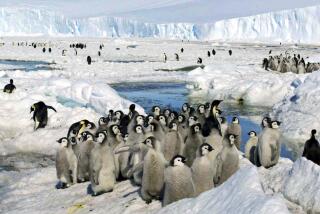What’s Black and White and All Over Antarctica?
- Share via
A sultry voice was warbling an Old World tune on the tape deck behind the bar as a bearded giant with eyes of glacial blue offered me a tumbler of vodka punch.
“Is homemade,” he said, smiling. “Is red for Christmas.”
This could have been a smoky cabaret in Gdansk, Poland, except for the lines of penguins that waited outside like gigolos eager to dance.
Such befuddlements are common in the spectacle that is Antarctica.
Strange lights cause strange illusions. Ice floes drift in the sky. Small objects appear larger than they are as perspective is shattered in the glistening cold world of white on white.
It is the penguins that underscore the sense of place. They are the reality. This vast, frozen continent is their home, and their population is in the millions.
They walk with you as you scale the slippery slopes; they talk with you in siren cries if you edge too near a nest. They preen for your camera, beaks tall to the sky, and then flop on their bellies to slide down the ice toward the sea.
Sparsely Populated
As for people in Antarctica, you can count them on your fingers and toes.
At Poland’s Arctowski station on King George Island there are 20 scientists: 19 Poles and a Russian named Igor. They live and perform research in one-story buildings that resemble boxcars. Average stay is a year.
On the outside the station is bleak--yellow and brown construction, a smudge on a field of white.
Amphibious vehicles are parked in disarray; guy wires stab at the sky.
On the inside it is as cozy as a ski hut, its bar and dining hall paneled in rich knotty pine. A somber portrait of Henryk Arctowski, for whom the station is named, dominates one corner.
Arctowski was the Polish geologist who came south in 1897 on the three-masted ship Belgica.
On the opposite wall is a calendar of Ansel Adams’ masterful photographs of Yosemite Park.
We were greeted at the station by a young Pole wearing blue jeans and a sweater. His stocking feet were in beach sandals that were stamped “Jogging.”
“Welcome to our summertime,” he said with a grin. We stepped up from the slushy ice and into the warmth of the entry hall, where sturdy coat hooks held hooded parkas and down vests and an army of caps and mufflers.
Well-Thumbed Material
He led us down a narrow corridor, beyond the scientists’ dormitory rooms, to a library packed with maps, games, novels, poetry, reference books and scientific journals.
Two shelves held well-thumbed material in English: Reader’s Digest’s “Antarctica,” Roger Tory Peterson’s “Penguins,” copies of the Ford Times and Smithsonian, plus a 1986 L. L. Bean catalogue.
“Any reading material is treasured down here,” a Pole named John told me. “We have much isolation, especially in winter. The mail comes in by supply boat maybe twice a year. When one person gets a letter from home, unless it is terribly personal, they post it in the mess hall so we all can share news from Poland.”
In addition to having a radio link, they screen old videotapes from Polish TV. Every scientist I talked to found the Antarctic assignment exhilarating.
“It is lonelier for our families than for us,” one researcher said. “We are involved with our work. There are few interruptions.”
We, of course, were interruptions. We had come ashore by invitation and in small numbers. A cruise ship nearing the Antarctic continent had sought to land 600 passengers and the Poles refused for the sake of their work and the protection of wildlife and rookeries.
After downing a mug of coffee, I suited up and followed John outside to another boxcar to see the Poles’ fabled greenhouse.
Vision of Color
Here in a world of black and white, they have nurtured a vision of spring. Tomato plants, heavy with fruit, climbed through the filtered sun in this glass cave that had been patched more than once after gales. Green peppers hung from vines.
There were beds of almost ripe strawberries and dill and other herbs. There are rows of flowers--daisies and pansies and snapdragons that grow in rich, dark earth.
“That is the soil of Poland,” John said proudly, scooping it up with his fingers. “It has come a long way, too.”
John knows his carpentry and is a bit of a prankster. He had posted a tall sign that said, “Bus Stop,” by the beach road that for two months of thaw leads to an oil tank and weather station.
I began to suspect that he was also responsible for a primitive cable tow I’d seen stretched up the snowy hill. But that he denied. “Ski lift is not joke,” he said. “Bus stop is joke.”
Our expedition leader, Lars-Eric Lindblad, who launched travel to Antarctica in the 1960s, had invited several of the Poles to join us on shipboard that evening.
After dinner we gathered in the lounge where the Greek crew played “Never on Sunday.” Then the Poles sang songs of home, as did Igor the Russian.
It could have been a cabaret in Gdansk or Piraeus, Greece, or Kiev, Russia--but for the icebergs that gleamed in the windows long after 10 p.m. and the lines of faithful penguins that waited on shore to walk their Polish pals home.
More to Read
Sign up for The Wild
We’ll help you find the best places to hike, bike and run, as well as the perfect silent spots for meditation and yoga.
You may occasionally receive promotional content from the Los Angeles Times.






